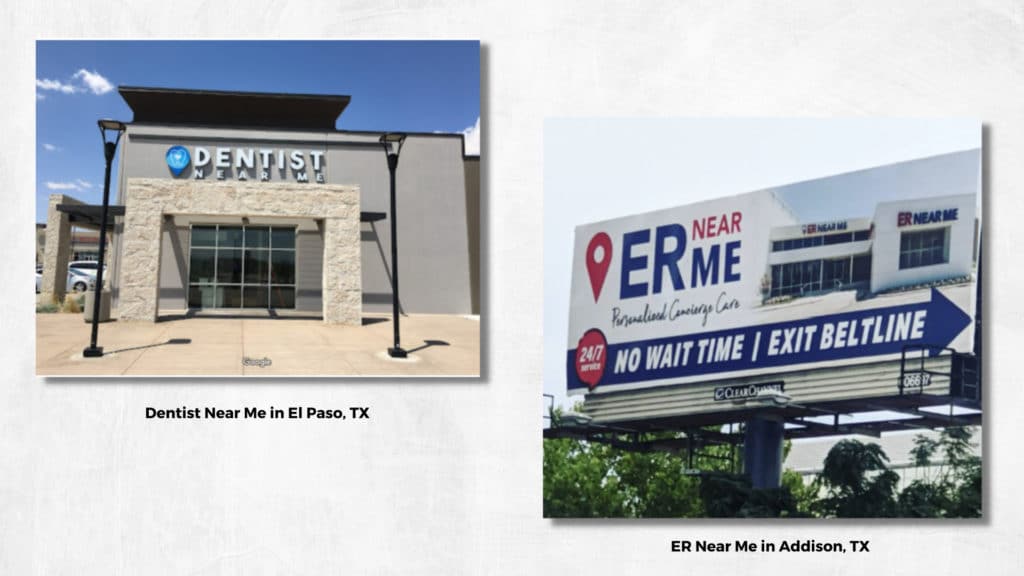For years, optimizing the Google search term “near me” was a common recommendation to boost your local SEO. However, with Google’s recent updates, this tactic might not be as beneficial as it once was. And businesses incorporating “near me” into their brand name might be doing more harm than good to their SEO strategy.
“Near Me” Search Optimization
Recently, stating that businesses with “near me” added in their name do not help rank higher in the local pack and Google Maps.
“Near Me” search queries are common for consumers trying to find a product or service that is in the closest proximity to their location. In fact, according to a recent article from Think with Google, penned by Bill Ready, “searches for “open now near me” have grown globally by over 400% YOY.”
“Open now” is a similar search term often used to determine locating businesses that are still open, or stay open outside of normal business hours. SEO experts have long known that “near me” search optimization carried the huge potential for keyword searches with businesses. And with Think with Google’s recent statistic, it’s further confirmation that consumers overwhelmingly use this in a high volume of local search terms.
Chris Smith, President of Ardent Media, conducted a keyword research trial on a local attorney firm. His findings showed that no other competing attorneys in that niche were using “near me” phrases. When he created an optimized page for his “near me” specialization phrase, the firm’s referrals increased by about 20%. The conclusion is that local businesses should still be optimized for their ideal keywords in combination with “near me” phrases. In other words, when your website included a page for “near me,” along with the industry business category name, many local businesses saw an increase in visibility.
“Near Me” Company Name
With the popular “near me” search queries established, many businesses took it a giant step further (maybe too far) by including “near me” in their company name. Here are two examples:

Part of this trend came from the fact that Google relied heavily on literal keyword matches, so finagling those exact keywords could potentially skyrocket a business in appearing in a local search. Well, as always, Google caught on to this. When it became clear that consumers were increasingly searching for local business while combining the “near me” keyword phrase in the queries, Google decided to simplify the process. Google has since changed it so that the “near me” query will return the closest matching local businesses for one’s search within the Maps/Local listings, without factoring in the “near me” keywords. In other words, they have extracted the “near me” portion of the user’s query and matched the other keywords based on the products and services that are in closest proximity.
“Near Me” Optimization: What’s Changed
Google configured search results based around the “near me” or “open now” to be centered around the user’s proximity, regardless of whether those keywords were present. Additionally, Google’s changes have essentially destroyed brand names using “near me” in search and Google Maps. Yikes. If you’re thinking about fooling Google by adding “near me” within your business name, think again. Because Google is now using the “near me” parts as a type of proximity indicator rather than a literal keyword match, the use of this in a brand name as an optimization tactic can be damaging.
Some might even argue that these brand names can come across as spammy or fake. That being said, those businesses can still rank for “near me” search queries – but it’s only dependent upon their proximity to the searcher.
This is one reason why relevance, proximity, and prominence are so important, and why your business’s website should be optimized for these factors. As you know, Google prioritizes profiles that meet all three criteria.
How Your Business Can Be Optimized For “Near Me” Searches
1. A Well-Optimized Google Business Profile
A GBP should include relevant information such as operating hours, location(s), accurate contact information, and more. It should also have a keyword-rich description, categories, important attributes, and high-quality images. and a current list of your products and services. And without a doubt, don’t forget to include a consistent flow of new and positive reviews. Make sure all this information is accurate and up-to-date across all listings, your website, and social media channels to avoid inconsistencies.
2. Include Location Pages on Your Website
Your website should have a separate page for each location of your business. Each location page should include a map, local business schema, your address, operating hours, phone number, and other features that help Google determine your relevance. This helps Google understand what products/services your brand offers in relation to a specific geographic area and local search query.
3. Audit Your Business Local Presence Often
Like all other aspects of SEO, it’s not a one-and-done process. At a minimum, audit your local presence on GBP, Bing, Yelp, social media, and other directory platforms – anywhere that gains local traffic. Check for accuracy, updates, and any recent Google changes that could impact your local presence. Keeping your online presence current is essential for Google.
Final Thoughts
While “near me” was once a headliner for keyword optimization, the times have (slightly) changed. If you’re a local business it’s important that people in your service area can easily find you. Bottom line, optimizing your site using local SEO strategies is key to your online presence. If you’re looking to increase your online traffic and get more eyes on your business, our team can help. Reach out to us for a free consultation to get started.

